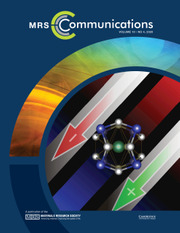Article contents
A VEDA simulation on cement paste: using dynamic atomic force microscopy to characterize cellulose nanocrystal distribution
Published online by Cambridge University Press: 24 July 2017
Abstract

Cellulose nanocrystal (CNC) enhances mechanical performance of cement composites via short-circuit diffusion (SCD). CNCs transport water along their hydrophilic surface into the unhydrated cement cores to induce extra hydration. It is important to characterize CNC distribution because it determines the SCD pathways. This study for the first time, employs virtual environment dynamic atomic force microscopy, an atomic force microscopy computational tool to investigate CNC distribution in both fresh and hardened cement pastes. The methods not only provide insights in a static context (hardened sample), but also offer opportunities to evaluate the interaction of CNCs with calcium-silicate-hydrate growth during the kinetic early ages of hydration.
Keywords
Information
- Type
- Research Letters
- Information
- Copyright
- Copyright © Materials Research Society 2017
References
- 4
- Cited by

